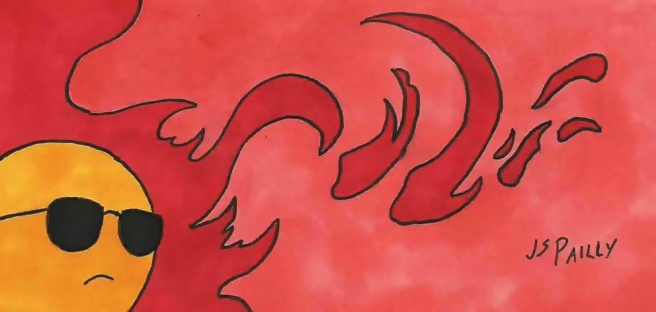
Today’s post is part of a special series here on Planet Pailly called Sciency Words. Each week, we take a closer look at an interesting science or science-related term to help us all expand our scientific vocabularies together. Today’s word is:
SOLAR WIND
The Sun produces more than just sunlight. In addition to boring, electrically neutral photons of various wavelengths, the Sun also unleashes a near constant onslaught of electrically charged particles that wreak havoc upon the Solar System.
These charged particles are collectively known as the solar wind, and they come in two groups: slow and fast. The slow solar wind originates mainly from the Sun’s equator and travels at a leisurely 400 kilometers per second. The fast solar wind moves at almost twice that speed. It comes from coronal holes (low density regions of the corona) which tend to form near the Sun’s poles.
Both types of solar wind exert a slight pressure on everything they touch, from planets and moons to comets and asteroids. This is a slight pressure, but over long stretches of time it’s enough to nudge asteroids off course, clear dust and debris from the inner Solar System, and strip away entire planetary atmospheres.
Luckily for us, Earth can protect itself. Remember: the solar wind is composed of electrically charged particles, and Earth has a global magnetic field. As a result, the solar wind cannot blast Earth directly. For the most part, the magnetic field either repels solar wind particles away or directs them toward Earth’s poles (where the particles trigger auroras).
That’s good news for us humans, but don’t relax yet. The solar wind varies in intensity, turning from a gentle breeze into explosive solar storms.

Earth’s magnetic field still protects our planet during these storms, but not our technology. We learned this the hard way in 1859 when a huge coronal mass ejection struck Earth head on. It was too much, and Earth’s magnetic field sort of freaked out, overloading the global network of telegraph wires. If this happened again today, with our fancy Internet and power grids and satellites, it would… actually, no one really knows what would happen.
Also, the solar wind is a form of radiation, composed primarily of broken pieces of hydrogen and helium atoms. The crew of the International Space Station are still protected (somewhat) by Earth’s magnetic field, and the Apollo Missions to the Moon were brief enough to keep total radiation exposure for astronauts fairly low.
But the future of human space exploration, both in reality and in science fiction, very much depends on this question: how do we protect ourselves from the solar wind?
Excellent point about astronauts outside of the Earth’s magnetic field needing protection from radiation. This is an issue that often gets overlooked or trivialized by Mars colonization enthusiasts.
The problem isn’t just in deep space. It’s also an issue for anyone standing on the surface of Mars. It’s why most Mars colonies are usually envisioned to exist underground. Mars is thought to once had a much thicker atmosphere, but the solar wind blasted it away over the eons.
I’d imagine this becomes less of an issue the further we move away from the sun. Not sure how much of a problem it remains in the asteroid belt, and it sure seems like it wouldn’t be a major issue in the Kuiper belt, where the overriding concern might actually be lack of solar energy.
LikeLiked by 1 person
I think the asteroid belt really illustrates the significance of the solar wind. The solar wind blasts a lot of lighter elements off of asteroids, and the asteroids change color as a result. So inner belt asteroids tend to be potato brown while outer belt asteroids are coal black, with a brown to black gradient for all the asteroids in between.
As for astronaut safety, either in space or on Mars, science fiction did not prepare me for that at all. Which is odd considering that the radiation hazards of space have been well documented going all the way back to the 1950’s.
LikeLike
Ah, I’d forgotten about silicate vs carbonaceous asteroids. So maybe outer asteroid miners might have an easier time of it.
For protection, one thing I’ve wondered is whether generating a magnetic field around the spacecraft is feasible. The only thing I don’t know is large it needs to be. If it has to be thousands of kilometers thick, that starts to look unfeasible. Even if it worked, every spacecraft might end up with its own Van Allen radiation belts, which would have to be dealt with eventually.
Another possibility I’ve seen discussed is putting all the spacecraft’s water storage along the outer hull, which would block most of the radiation. Although I’ve never understood how that doesn’t result in the astronauts drinking radiated water.
LikeLiked by 1 person
I’d never thought about a spaceship having its own Van Allen belts. That would make a lot of sense. Could present some interesting story possibilities too.
I’m not sure what happens to water when it blocks radiation. I’d think the water molecules would break apart and recombine, so you’d get ozone and hydrogen and hydroxide mixed with your water. That can’t be good.
But if you can filter that stuff out, I’d think the water would still be safe to drink.
LikeLiked by 1 person
A lot of water purification systems use ozone.
LikeLiked by 1 person
I did not know that. Maybe irradiating our space water isn’t such a bad idea after all.
LikeLike